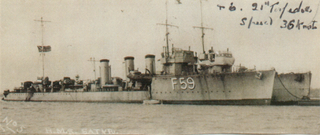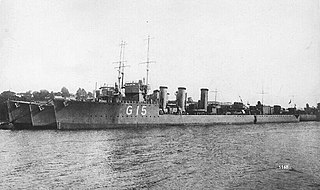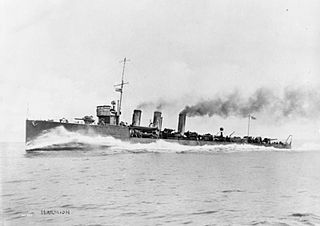HMS Starfish was an R-class destroyer which served with the Royal Navy. She was launched on 27 September 1916 and sold to be broken up on 21 April 1928. She was built by Hawthorn Leslie of Hebburn Tyne.

HMS Surprise was a Royal Navy R-class destroyer constructed and then operational in the First World War. She was sunk, with most of her crew in 1917. On 23 December 1917 HMS Surprise, Torrent, and Tornado sank after entering an Imperial German minefield.

HMS Nimrod was a Marksman-class flotilla leader of the British Royal Navy. She was built by the Scottish shipbuilder Denny, with construction starting in 1914 and completed in August 1915. She served through the remainder of the First World War. She was sold for scrap in 1921.

HMS Teazer was an R-class destroyer which served with the Royal Navy during World War I. The destroyer was launched in April 1917 and, on trial, proved to be one of the fastest afloat, exceeding 40 knots. Attached to the Harwich Force, the ship supported the monitors Erebus, Terror and Marshal Soult in the bombardment of Zeebrugge in May 1918 and one of the final sorties of the war in the October following. The destroyer also took part in operations off the coast of Heligoland with a flying boat on a lighter, although the aircraft failed to take off. After the war, Teazer was kept in reserve until being sold to be broken up in 1931 following the signing of the London Naval Treaty that limited total destroyer tonnage.

HMS Rob Roy was a Royal Navy R-class destroyer constructed and then operational in the First World War. The ship served in the Grand Fleet as part of the Fifteenth Destroyer Flotilla.

HMS Retriever was a Thornycroft-built R-class destroyer which served with the Royal Navy during the First World War. Launched in 1917, the vessel formed part of the Harwich Force and took part in operations off the coast of Ostend in support of the bombardment of the town in June that year. During August the following year, the vessel attempted to deploy a seaplane from a towed lighter, but a lack of wind meant the operation was unsuccessful. The vessel was also jointly credited with the destruction of the submarine SM UB-54 that year, although this has been disputed. After the war, the ship was placed in reserve and was sold to be broken up in 1927.

HMS Satyr was an R-class destroyer which served with the Royal Navy during the First World War. Launched on 27 December 1916, Satyr joined the Harwich Force under the command of Commander Hubert de Burgh. In 1917, the destroyer formed part of a force protecting the monitors Erebus and Terror in their bombardment of Ostend. As part of this action, Satyr, along with sister ships Taurus, Sharpshooter and Torrent, sank the German destroyer S20. After the war, the ship served with the Torpedo School at the Devonport. In 1923, the Navy decided to retire many of the older destroyers in preparation for the introduction of newer and larger vessels and Satyr was sold to be broken up on 16 December 1926.

HMS Sorceress was an R-class destroyer which served with the Royal Navy during World War I. Launched on 29 August 1916, the vessel operated as part of the Grand Fleet until it was disbanded in 1919. In 1917, the ship took part in action against the German Sixth Destroyer Flotilla and was one of those credited with bounty for the German auxiliary cruiser Konprinz Willhelm. The destroyer was sold to be broken up on 29 April 1927.

HMS Sharpshooter was an R-class destroyer which served with the Royal Navy during World War I. Launched on 27 February 1917, the ship joined the Harwich Force, undertaking convoy escort duties. The vessel also took part in the Navy’s bombardment of Ostend later that year. On 1 June 1918, the destroyer rescued Captain A. C. Sharwood, one of the first pilots of the Royal Australian Navy, who ditched his Sopwith 2F.1 Camel nearby. After the war, Sharpshooter joined the Navy gunnery training establishment at Plymouth, but did not stay long and was reduced to Reduced Complement on 5 March 1919. The Royal Navy was rationalising its destroyer force and Sharpshooter, deemed superfluous, was sold to be broken up on 29 April 1927.

HMS Simoom was an S-class destroyer which served with the Royal Navy. Launched on 26 January 1918, the vessel operated as part of the Grand Fleet during the last months of World War I. At the end of the conflict, Simoom was placed in reserve and scrapped on 8 January 1931. The name was reused from an R-class destroyer sunk on 23 January 1917.
HMS Grenville was a Parker-class flotilla leader of the British Royal Navy. She was built by Cammell Laird during the First World War, being launched on 17 June 1916 and completing on 11 October that year. Grenville served with the Grand Fleet for the rest of the war, which she survived. The ship took part in operations in the Baltic during the Russian Civil War in the winter of 1919–1920, before entering a long period of reserve. She was sold for scrap in December 1931.

HMS Rigorous was an R-class destroyer which served with the Royal Navy during World War I. Launched on 30 September 1916, the vessel operated as part of the Grand Fleet, operating as part of destroyer flotillas hunting German ships that were attacking convoys. One flotilla was successful in destroying a Q ship in 1917. After the War, the destroyer was given a reduced complement and was sold to be broken up on 5 November 1926.

HMS Restless was an R-class destroyer which served with the Royal Navy during World War I. Launched on 12 August 1916, the ship operated as part of the Grand Fleet, operating as part of a destroyer flotilla protecting convoys in the North Sea. After the War, the destroyer served in the Mediterranean Sea and was sold to be broken up on 23 November 1936.

HMS Rowena was an R-class destroyer which served with the Royal Navy during World War I. Launched on 1 July 1916, the ship operated as part of the Grand Fleet as part of a destroyer flotilla hunting for German vessels that were attacking convoys in the North Sea. Although there were many reported sightings, no submarines were sunk. After the conflict, the vessel was transferred to the Navy’s establishment at Portland to help in the development of anti-submarine warfare, which ultimately helped in the Battle of the Atlantic. Rowena did not, however, see the fruit of this labour. After twenty years of service, the destroyer was retired and sold to be broken up on 27 January 1937.

HMS Romola was an R-class destroyer which served with the Royal Navy during World War I. Launched on 14 May 1916, the ship operated as part of the Grand Fleet, operating as part of a destroyer flotilla. The ship sailed to intercept the German High Seas Fleet in what would be one of the last major expeditions of their Navy in the war but saw no action. After the conflict, the destroyer was held in reserve until being retired and sold to be broken up on 13 March 1930.
HMS Melpomene was a Medea-class destroyer of the British Royal Navy. She was one of four destroyers, of similar design to the British M-class ordered by Greece in June 1914, which the British purchased during construction owing to the outbreak of the First World War.

HMS Pellew was a Admiralty M-class destroyer which served with the Royal Navy during the First World War. The M class were an improvement on the preceding L class, capable of higher speed. Launched on 18 April 1916, the vessel served with the Grand Fleet escorting convoys. The vessel was part of an unsuccessful attempt by the navy to trap the German submarines that had taken such a heavy toll on merchant shipping in December 1917. The action involved an eight-ship convoy consisting of four merchant vessels escorted by two armed trawlers and the sister ships Pellew and Partridge. Instead of submarines, four German destroyers attacked, sinking all but one member of the convoy and disappearing before the light cruisers which were to be the spring in the trap could arrive. Pellew, the sole survivor, took refuge in a Norwegian fjord. After the armistice that ended the war, the destroyer was placed in reserve and subsequently sold to be broken up on 9 May 1921.

HMS Moorsom was an Admiralty M-class destroyer which served in the Royal Navy during the First World War. The M class was an improvement on the preceding L class, capable of higher speed. Moorsom, the first ship to enter navy service to be named after Admiral Sir Robert Moorsom, was launched in December 1914, initially serving as part of the Grand Fleet before being transferred to the Harwich Force the following year. Briefly rejoining the Grand Fleet, the destroyer saw service in the Battle of Jutland in 1916 supporting the British battlecruisers and received hits from a battleship of the German High Seas Fleet. Moorsom also undertook other duties, including escorting the troop ship Mauretania in June 1915 and the minelayer Princess Margaret in August 1915 and November 1916. Placed within the Dover Patrol, the destroyer formed part of the cover for monitors including Erebus and Terror on attacks on Ostend and Zeebrugge in May and June 1917, and April and May 1918. After the Armistice, the destroyer was placed in reserve and subsequently sold to be broken up in November 1921.

HMS Morris was an Admiralty M-class destroyer which served with the Royal Navy during the First World War. The M class were an improvement on the preceding L class, capable of higher speed. The ship, the only vessel to be named Morris to serve with the Royal Navy, was launched on 19 November 1914. Joining the Grand Fleet as part of a new flotilla, the destroyer was soon in action, serving as part of a destroyer screen during the Battle of Dogger Bank in January 1915 and an escort to the minelayer Princess Margaret during a skirmish with German torpedo boats eight months later. At the Battle of Jutland in 1916, the destroyer was a crucial part of the flotilla that drove the German torpedo boats away from the British battlecruisers. Morris received no hits during these confrontations. The destroyer assisted in the rescue of survivors from the R-class destroyer Simoom and the recovery of the damaged flotilla leader Botha in 1917. The ship also undertook general duties including escorting merchant ships, minelayers, monitors, and the seaplane carrier Vindex. After the armistice that ended the war, the destroyer was considered superfluous to requirements, Initially placed in reserve, Morris was decommissioned and, on 8 November 1921, sold to be broken up.

HMS Stork was an R-class destroyer that served in the Royal Navy during the First World War. The R-class were an improvement on the previous M-class with geared steam turbines to improve efficiency. Launched by Hawthorn Leslie at Hebburn in 1917, Stork joined the Harwich Force. The destroyer saw service escorting convoys in the English Channel and encountered both German submarines and torpedo boats, but did not record any hits on the enemy. The vessel also supported attacks on German forces on the coast of Western Europe by Coastal Motor Boats, flying boats and monitors, including the Zeebrugge Raid of 1918.











